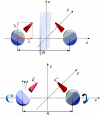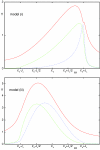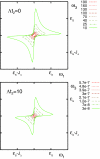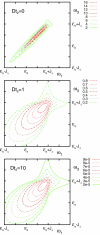Novel coherent two-dimensional optical spectroscopy probes of chirality exchange and fluctuations in molecules
- PMID: 22112074
- PMCID: PMC3248026
- DOI: 10.1063/1.3658277
Novel coherent two-dimensional optical spectroscopy probes of chirality exchange and fluctuations in molecules
Abstract
We demonstrate how stochastic transitions between molecular configurations with opposite senses of chirality may be probed by 2D optical signals with specific pulse polarization configurations. The third-order optical response of molecular dimers (such as biphenyls) with dynamical axial chirality is calculated to order of k(2) in the wavevector of light. Spectroscopic signatures of equilibrium chirality fluctuations are predicted for three dynamical models (Ornstein-Uhlenbeck, two-state jump, and diffusion in double well) of the dihedral angle that controls the chirality.
Figures









Similar articles
-
Probing chirality fluctuations in molecules by nonlinear optical spectroscopy.J Chem Phys. 2014 Dec 21;141(23):234305. doi: 10.1063/1.4903858. J Chem Phys. 2014. PMID: 25527933 Free PMC article.
-
Exciton coherence length fluctuations in chromophore aggregates probed by multidimensional optical spectroscopy.J Chem Phys. 2010 Jul 7;133(1):014102. doi: 10.1063/1.3442415. J Chem Phys. 2010. PMID: 20614954 Free PMC article.
-
Chirality-based signatures of local protein environments in two-dimensional optical spectroscopy of two species photosynthetic complexes of green sulfur bacteria: simulation study.Biophys J. 2008 Nov 15;95(10):4896-907. doi: 10.1529/biophysj.108.134387. Epub 2008 Aug 1. Biophys J. 2008. PMID: 18676650 Free PMC article.
-
Two-dimensional nonlinear optical activity spectroscopy of coupled multi-chromophore system.Phys Chem Chem Phys. 2008 Jul 14;10(26):3839-56. doi: 10.1039/b719263k. Epub 2008 Apr 9. Phys Chem Chem Phys. 2008. PMID: 18688382 Review.
-
The Optical Signatures of Stochastic Processes in Many-Body Exciton Scattering.Annu Rev Phys Chem. 2023 Apr 24;74:467-492. doi: 10.1146/annurev-physchem-102822-100922. Epub 2023 Feb 28. Annu Rev Phys Chem. 2023. PMID: 36854178 Review.
Cited by
-
Anharmonic Molecular Motion Drives Resonance Energy Transfer in peri-Arylene Dyads.Front Chem. 2020 Nov 23;8:579166. doi: 10.3389/fchem.2020.579166. eCollection 2020. Front Chem. 2020. PMID: 33330367 Free PMC article.
-
Probing ring currents in Mg-porphyrins by pump-probe spectroscopy.J Phys Chem A. 2012 Nov 26;116(46):11095-100. doi: 10.1021/jp3035874. Epub 2012 Aug 10. J Phys Chem A. 2012. PMID: 22881200 Free PMC article.
-
Probing chirality fluctuations in molecules by nonlinear optical spectroscopy.J Chem Phys. 2014 Dec 21;141(23):234305. doi: 10.1063/1.4903858. J Chem Phys. 2014. PMID: 25527933 Free PMC article.
References
-
- Flapan E., When Topology Meets Chemistry: A Topological Look at Molecular Chirality (Cambridge University Press, Cambridge, England, 2000).
-
- Mason S. F., Molecular Optical Activity and the Chiral Discriminations (Cambridge University Press, Cambridge, England, 2009).
-
- The Physical Chemistry of Chirality, edited by Hicks J. M. (American Chemical Society, Washington, D.C., 2001).
Publication types
MeSH terms
Substances
Grants and funding
LinkOut - more resources
Full Text Sources

